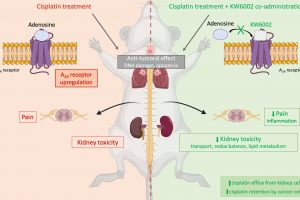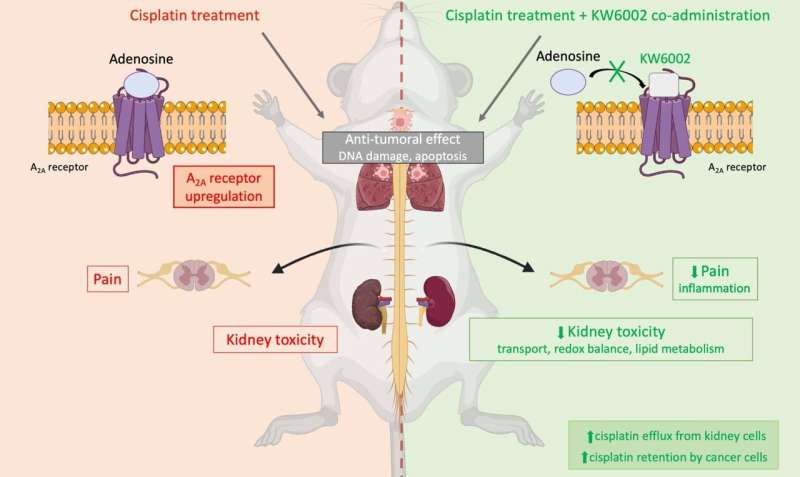A potential therapy to reduce the side effects of chemotherapy


Cisplatin is a chemotherapy indicated to fight tumors in many types of cancer. However, it does have major side effects—especially kidney toxicity, that can lead to acute kidney failure.
In addition, patients treated with cisplatin also often report high levels of neuropathic pain. Scientists from Inserm, Université de Lille, University Hospital Lille, CNRS and Institut Pasteur de Lille within the CANTHER and Lille Neuroscience & Cognition laboratories, in collaboration with researchers from Michigan State University (USA), have identified a drug that could be a game changer for patients.
Istradefylline, which is already approved for Parkinson’s disease, could not only reduce the harmful effects of cisplatin but also improve its anti-tumor properties. These findings will now need to be confirmed in a clinical trial. The study is published in the Journal of Clinical Investigation.
Cisplatin is a chemotherapy used to treat several types of cancer, in particular lung, ovarian and testicular cancers. While its anti-tumor efficacy has been proven, cisplatin promotes side effects. These include intense pain (peripheral neuropathy) and kidney damage, leading to acute kidney failure in one third of cases. Currently, there is no effective solutions to limit side effects for patients exposed to cisplatin.
An international work conducted by Christelle Cauffiez, David Blum and Geoffroy Laumet have now identified a molecule that reduces cisplatin-induced side effects, while preserving or even potentiating its anti-tumor properties.
A Parkinson’s disease drug
The scientists focused on a drug called istradefylline, which is already approved in the USA and Japan for the treatment of Parkinson’s disease. Biologically, this compound blocks the adenosine receptors receptors at the surface of cells.
Blum’s team, which is working on neurodegenerative diseases, had previously observed an increased density of these receptors in the brains of patients with dementia, a phenomenon involved in the development of these diseases. Interestingly, a comparable increase of adenosine receptors was also observed by Cauffiez’s team in the kidneys, under exposure to cisplatin.
With this in mind, the scientists decided to join forces with Laumet’s lab, a specialist of cisplatin-induced neuropathic pain, to test the impact of istradefylline to mitigate the harmful effects of cisplatin.
Findings to confirm in a clinical trial
Their experiments, conducted on animal and cellular models, indeed pointed towards a beneficial role of istradefylline. In mice exposed to cisplatin, the molecule not only reduced kidney damages but also prevented neuropathic pain.
In addition, cisplatin’s ability to reduce tumor growth was increased in the animals receiving istradefylline—an effect subsequently confirmed in cell models.
Before considering the widespread application of this therapeutic approach to patients with cancer, these findings must however first be consolidated by organizing a rigorous clinical trial. The fact that istradefylline is already used in humans to treat another disease already constitutes an interesting perspective.
“In fact, we already have a lot of clinical data showing that this molecule is safe. While it is necessary to conduct a clinical study to test its efficacy in reducing the side effects of the chemotherapy, the possibility of therapeutic repositioning is a promising perspective for improving patient care in the short term,” the researchers point out.
More information:
Edmone Dewaeles et al, Istradefylline protects from cisplatin-induced nephrotoxicity and peripheral neuropathy while preserving cisplatin antitumor effects, Journal of Clinical Investigation (2022). DOI: 10.1172/JCI152924
Journal information:
Journal of Clinical Investigation
Source: Read Full Article




